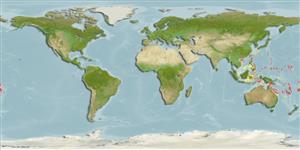Teleostei (teleosts) >
Blenniiformes (Blennies) >
Tripterygiidae (Triplefin blennies) > Tripterygiinae
Etymology: Enneapterygius: Greek, ennea = nine times + Greek, pterygion = little fin (Ref. 45335).
More on author: Fricke.
Environment: milieu / climate zone / depth range / distribution range
Ecology
Marine; demersal; non-migratory; depth range 0 - 15 m (Ref. 13227). Tropical
Western Pacific.
Size / Weight / Age
Maturity: Lm ? range ? - ? cm
Max length : 3.2 cm SL male/unsexed; (Ref. 13227); 2.9 cm SL (female)
Dorsal spines (total): 12 - 15; Dorsal soft rays (total): 8 - 10; Anal spines: 1; Anal soft rays: 16 - 19. 9-12 spines in the second dorsal fin, 8-10 rays in the third dorsal fin, 17-20 anal fin rays, 32-37 + 1 lateral scale rows, 13-19 + 17-22 lateral line scales, two median mandibular pores, a black band on the caudal peduncle, about 9 basal dark spots on the female's anal fin, and a overall blackish coloration of the male.
Adults inhabit rock and coral reefs (Ref. 90102), from the surface to 15 m, including intertidal pools (Ref. 13227). Eggs are hemispherical and covered with numerous sticky threads that anchor them in the algae on the nesting sites (Ref. 240). Larvae are planktonic which occur primarily in shallow, nearshore waters (Ref. 94114).
Life cycle and mating behavior
Maturity | Reproduction | Spawning | Eggs | Fecundity | Larvae
Fricke, R., 1994. Tripterygiid fishes of Australia, New Zealand and the southwest Pacific Ocean (Teleostei). Theses Zool. 24:1-585. (Ref. 13227)
IUCN Red List Status (Ref. 130435: Version 2024-1)
Threat to humans
Harmless
Human uses
Fisheries: of no interest
Tools
Can't connect to MySQL database fbquizv2. Errorcode: Too many connections
